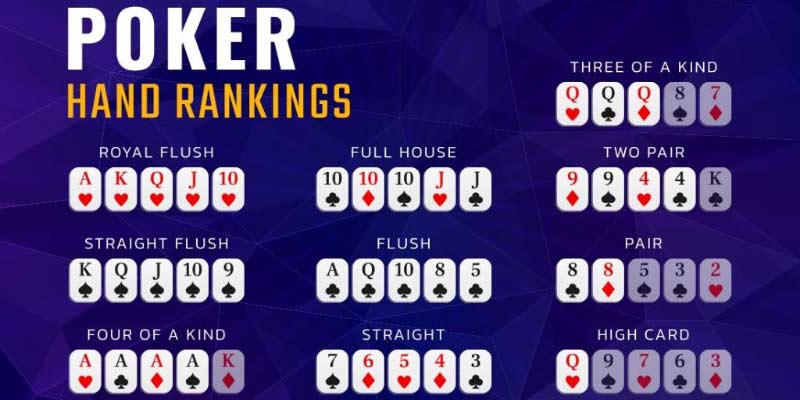
Poker Hand Rankings - A Comprehensive Guide
Poker hand rankings are a crucial aspect of the game that every player must understand to succeed. Knowing how hands compare against each other can significantly alter your approach to strategy and improve your overall gameplay 789bet.
Who Poker Hand Rankings Are For
Poker hand rankings apply to all players, regardless of skill level or experience. Understanding these rankings is essential for:
- New Players: If you’re just starting out, grasping poker hand rankings allows you to participate confidently in games and tournaments.
- Intermediate Players: For those who have played a few hands but want to strategize better, knowing the hand rankings will enable you to make more informed decisions during play.
- Experienced Players: Even seasoned players revisit hand rankings to refine their strategies and enhance their analytical skills.
The importance of understanding poker hand rankings cannot be overstated. They serve as the foundation for making strategic decisions at the table and can often be the difference between winning and losing. By mastering this concept, you can develop a sophisticated understanding of the game and increase your chances of success.
The Basics of Poker Hand Rankings
At its core, poker hand rankings classify different combinations of cards into a hierarchical structure. The highest-ranking hands win over lower-ranking ones, and this hierarchy varies depending on the version of poker being played. Here’s a brief overview:
Royal Flush
A Royal Flush consists of the Ace, King, Queen, Jack, and Ten of the same suit. This is the highest possible hand in poker and is unbeatable.
Straight Flush
A Straight Flush consists of five consecutive cards of the same suit. An example would be 5, 6, 7, 8, and 9 of hearts.
Four of a Kind
This hand contains four cards of the same rank, which is often complemented by a fifth card called the kicker.
Full House
A Full House combines three cards of one rank and two cards of another rank. It blends security and flexibility in gameplay.
Flush
A Flush is made up of five cards of the same suit, not in sequential order. The strength of the Flush is determined by the highest card https://789bet.domains/.
Straight
A Straight includes five consecutive cards of different suits. The highest card in the sequence determines the hand’s strength.
Three of a Kind
This hand has three cards of the same rank, and it can be bolstered by two additional cards called kickers.
Two Pair
Two Pair consists of two cards of one rank and two cards of another rank, plus a fifth card.
One Pair
One Pair includes two cards of the same rank with three unrelated cards.
High Card
When no other hand category is achieved, the highest single card plays. If multiple players hold high cards, the next highest card is evaluated as a tiebreaker.
How Poker Hand Rankings Work in Gameplay
Understanding how poker hand rankings work is vital for effective gameplay. In competitive scenarios, players are consistently evaluating their own hands against others. Let’s delve deeper into how they influence decision-making.
Betting Strategies Based on Hand Rankings
Your betting strategy should shift according to the strength of your hand. Strong hands like a Royal Flush warrant aggressive bets to maximize potential winnings. Conversely, weaker hands may compel you to play conservatively.
Reading Opponents’ Hands
While you can’t see your opponents’ cards, you can infer their potential hands based on their betting behavior. Learning to read your opponents can give you insights into whether you are ahead or behind in the hand rankings.
Bluffing Tactics
Understanding poker hand rankings enhances your ability to bluff effectively. A well-timed bluff can force an opponent to fold a stronger hand if you project confidence in a higher ranking.
Adaptation During Play
As you play, the dynamics of the game can change rapidly. Being flexible in your approach can help capitalize on opportunities, especially when you’ve gauged where you stand in terms of hand rankings.
Pros and Cons of Poker Hand Rankings
Like any system, poker hand rankings come with their own set of advantages and disadvantages that influence how players engage with the game.
Advantages of Knowing Hand Rankings
- Strategic Insights: Recognizing the strength of your hand allows you to devise a successful game plan, increasing your odds of winning.
- Improved Decision-Making: Knowledge of rankings improves judgment during high-pressure situations, enabling smarter calls and bluffs.
- Increased Confidence: Familiarity with hand rankings fosters self-assurance, particularly for novice players who might be intimidated by more experienced opponents.
Disadvantages of Relying Solely on Hand Rankings
- Overemphasis on Rankings: Focusing too much on hand rankings may lead to poor choices, such as overvaluing a weak hand simply because it has a recognizable rank.
- Neglecting Other Elements: Successful poker involves psychological components like reading opponents, managing chips, and understanding betting patterns. Overlooking these aspects can weaken your overall game.
- Complacency: Players who become too comfortable with hand rankings may stop evolving their strategies, leading to stagnation.
Alternatives to Poker Hand Rankings
While poker hand rankings are a fundamental aspect of the game, there are alternative approaches to engage with poker that can improve your overall experience and strategy.
Game Variations
Different versions of poker have unique rules and structures that may alter the significance of hand rankings. Some alternatives include:
- Omaha: Players receive four hole cards instead of two, creating a different dynamic that can complicate hand evaluation.
- Seven-Card Stud: This variant does not use community cards, changing how players assess their hand strength.
Tournament Structures
The structure of a poker tournament can influence how you view hand rankings. For example, in early stages, conservative play might be favored, while in later rounds, aggressive tactics become more important.
Cash Games vs. Tournaments
Cash games operate with different stakes and rules compared to tournaments, affecting hand ranking applications. In cash games, the emphasis on immediate chip acquisition may overshadow conventional hand rankings.
Step-by-Step to Master Poker Hand Rankings
Mastering poker hand rankings is a journey that requires practice and dedication. Below is a step-by-step guide that can help players navigate through the complexities of hand evaluations.
Step One: Familiarization
Start by memorizing the basic poker hand rankings. Use flashcards or apps designed for rapid learning to reinforce your understanding.
Step Two: Simulation Practice
Utilize online poker simulators or apps to practice playing hands without financial pressure. This will help solidify your understanding of how hands interact within varying contexts.
Step Three: Analyze Real Games
Watch professional poker games or streams and focus on how players evaluate hands. Take note of their strategies concerning hand rankings and adapt them to your gameplay.
Step Four: Participate Regularly
Engage in local poker games or online platforms where you can test your knowledge in real-time. The more you play, the better you’ll become at assessing hand strengths quickly.
Step Five: Reflect on Your Gameplay
After each session, review your hands and decisions Poker hand rankings. Ask yourself whether you utilized your understanding of hand rankings effectively. Continuous analysis is key to refining your approach.



